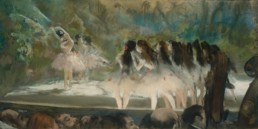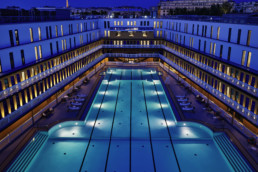In this dusty room where time seems to have stood still, Edgar Degas, armed with his pastels, embarks on an artistic exploration that marries tradition and innovation. With this piece, he revisits the theme of resting ballerinas, a subject dear to his work of the 1870s. But here, he goes beyond mere studies of backlighting that transform bodies into anonymous silhouettes; he delivers a work of unparalleled richness and depth.
A Reinvention of Art
By 1884, Degas was at a turning point in his career. He simplified his compositions, reduced the depth of his pictorial space, and brought the viewpoint down to a more natural height. Far from the caricatures that peppered his earlier works, he now aspired to a simplicity and clarity that responded to the expectations of critics and the public. Dancers thus becomes a manifesto against the excessive complexity of contemporary painting.
A nearly square format, rare for Degas at the time, frames six grouped ballerinas, their white tutus creating fluid transitions between their bodies. This creature with multiple heads, arms, and legs seems to animate the dance room with a life of its own. The harsh light enhances the brightness of their shoulders and their blonde or red hair, while the pastels capture the airy texture of their tutus and the gray, dusty aspect of the space.
Studio Anecdotes
During a visit to his studio, a renowned critic, fascinated by the strangeness and beauty of these dancers, asked Degas about his choice of colors and forms. The artist, with his enigmatic smile, simply replied, “Simplicity is the resolved complexity.” This response, both clear and cryptic, left the interlocutor deep in thought.
On another day, a young ballerina, a model for one of the figures in the painting, recounted how Degas had asked her to maintain a difficult pose for hours. Her back arched, arms extended toward the invisible, she still remembered the concentration and exhaustion, but also the magic of the moment when the artist, after hours of silence, whispered to her, “Perfect, you are movement incarnate.”
Light and Color
Degas plays with uneven light, creating striking contrasts that accentuate the blonde hair or the brightness of a shoulder. The pastels, sometimes dense, sometimes light, wonderfully render the airy texture of the tutus and the grayness of the room. Bursts of red and almost greenish-yellow enliven the dancers’ chignons, adding touches of vibrancy to this nearly monochromatic scene.
This work heralds the impressive series of dancers that Degas would create in the 1890s and 1900s, where he would revisit similar gestures and poses, playing with a variety of colors. However, Dancers remains unique, a masterpiece without replicas or variations, proving the astonishing vitality of the artist at a time when Impressionism itself seemed to be faltering.
Conclusion
Degas’ Dancers is much more than a mere depiction of ballerinas; it is a profound reflection on the fleetingness of the moment and the quest for the timeless. Through this work, Degas offers us a meditation on movement and light, on rediscovered simplicity, and the discreet brilliance of moments stolen from time.
Lire également :
18 November 2024
Au Rocher de Cancale
12 November 2024
George V: A Palace of Beauty and Tranquility
9 November 2024
Wrapped Memories: Christo’s Arc de Triomphe
28 May 2019
Geneviève Grad
21 June 2017
Molitor: Paris’ Timeless Oasis
22 May 2017
The “Collier de Chien” Bracelet by Hermès
21 January 2017


















